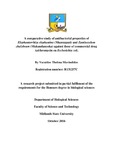Please use this identifier to cite or link to this item:
https://cris.library.msu.ac.zw//handle/11408/2552Full metadata record
| DC Field | Value | Language |
|---|---|---|
| dc.contributor.author | Mavindidze, Varaidzo Thelma | - |
| dc.date.accessioned | 2017-07-06T14:42:39Z | - |
| dc.date.available | 2017-07-06T14:42:39Z | - |
| dc.date.issued | 2016 | - |
| dc.identifier.uri | http://hdl.handle.net/11408/2552 | - |
| dc.description.abstract | A study was carried out at the Midlands State University during the month of September 2016, to compare the antibacterial properties of Elephantorrhiza elephantine (Muzezapasi) and Zanthoxylum chalybeum (Mukundanyoka), against those of the commercial drug Azithromycin on Escherichia coli. Plant extracts were purchased, sun dried and ground into fine powders. Azithromycin tablets were also purchased. Escherichia coli bacteria were isolated from the University toilets. Confirmatory tests were used to verify Escherichia coli. The three treatment drugs were then prepared into percentage solutions of 1%, 5%, 10%, 25% and 40% for E. elephantine and Z. chalybeum alone. A control was also prepared with sterile distilled water. Filter paper discs of a diameter of 6mm were prepared and embedded with the treatment drug percentage solution. Mueller hinton agar was inoculated with E.coli and the treated filter paper discs were placed on the media and incubated for 18 hours at 37°C. Zones of inhibition (ZOI) were measured in millimetres. Comparisons on the effectiveness of the drugs were then done and the results showed that the standard drug Azithromycin was the most effective. Azithromycin had the lowest inhibitory effect of 12mm at 1% concentration and a highest inhibitory effect of 27mm at 25%. Its general inhibitory effect increased by an average of 15mm from 1% to 25%. Azithromycin’s most significant increase was 10mm between 1% and 5%. Elephantorrhiza elephantine was more effective than Zanthoxylum chalybeum at lower percentage concentrations as it showed some inhibitory effect at 1% and 5% of 7mm and 8mm respectively and Zanthoxylum chalybeum showed no inhibitory effect at all at the two lowest concentrations. Elephantorrhiza elephantine had an average total inhibitory effect of 15mm. Its most significant inhibitory effect occurred between 25% and 40% at 7mm zone of inhibition diameter. Zanthoxylum chalybeum inhibition effect started at 10% concentration and its most significant increase was between 25% and 40% at 8mm zone of inhibition diameter, which was similar to that of Elephantorrhiza elephantine. Elephantorrhiza elephantine and Zanthoxylum chalybeum had the same average effectiveness of 8mm at 25% concentration. The results concluded that the commercial drug is greatly more effective than the unstandardized plant treatments, meaning that its dosage must be less than that of the plant drugs. Azithromycin therefore can have different dosages starting from below 1% because its 1% concentration has significant antibacterial effectiveness. The two plants Elephantorrhiza elephantine and Zanthoxylum chalybeum have an insignificant difference in effectiveness maybe due to differences in active ingredients and mode of action on bacteria, and so their dosages may be the same and should be in concentrations higher than 25% as their effectiveness is significant from that point going to higher concentrations. | en_US |
| dc.language.iso | en | en_US |
| dc.publisher | Midlands State University | en_US |
| dc.subject | Antibacterial properties | en_US |
| dc.title | A comparative study of antibacterial properties of Elephantorrhiza elephantine (Muzezapasi) and Zanthoxylum chalybeum (Mukundanyoka) against those of commercial drug Azithromycin on Escherichia coli. | en_US |
| item.grantfulltext | open | - |
| item.languageiso639-1 | en | - |
| item.fulltext | With Fulltext | - |
| Appears in Collections: | Bsc Biological Sciences Honours Degree | |
Files in This Item:
| File | Description | Size | Format | |
|---|---|---|---|---|
| R131257C.pdf | Full Text | 582.73 kB | Adobe PDF |  View/Open |
Page view(s)
166
checked on Apr 18, 2025
Download(s)
122
checked on Apr 18, 2025
Google ScholarTM
Check
Items in MSUIR are protected by copyright, with all rights reserved, unless otherwise indicated.



